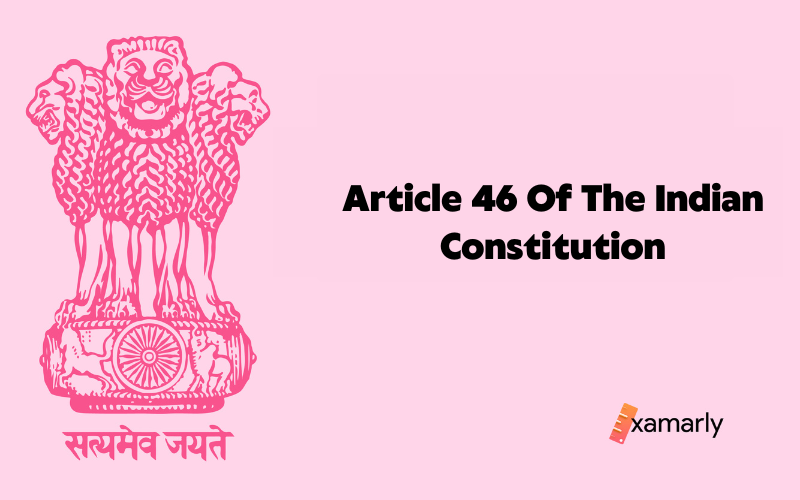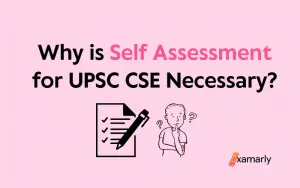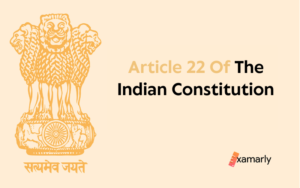India is home to a myriad of people coming from different social and cultural backgrounds. All these classes co-exist with each other and are also interdependent. However, there are marginalized groups in Indian society whose contributions to society are neglected.
The Constitution of India attempts to protect the rights of every citizen in a just and unbiased manner. It ensures that constitutional provisions for the upliftment of such weaker sections of society are put in place so that their standard of living can improve. Article 46 of the Indian constitution as a constitutional provision is a step in the direction of uplifting the education and economic condition of the weaker and downtrodden sections of society.
Let us explore Article 46 of the Indian Constitution in greater detail below.
Article 46 Of The Indian Constitution: Advocating The Cause Of Weaker Sections
- Article 46 of the Indian Constitution is particularly aimed at the educational and economic interests of the weaker sections of society. These include Scheduled Castes, Scheduled Tribes, and Other Backward Classes. In addition to that, it also aims to eradicate and protect the people belonging to Scheduled Castes and Scheduled Tribes from all forms of social injustice and exploitation that are targeted at them.
- It reads “46. Promotion of educational and economic interests of Scheduled Castes, Scheduled Tribes, and other weaker sections. The State shall promote with special care the educational and economic interests of the weaker sections of the people, and, in particular, of the Scheduled Castes and the Scheduled Tribes, and shall protect them from social injustice and all forms of exploitations.”
- It falls under Directive Principles of State Policy (DPSP) and is an article following the ideology of the Gandhian Principle.
Background Of Article 46 Of The Indian Constitution
- Article 46 of the Indian Constitution was finalized from Draft Article 37.
- This Draft Article was focused on the upliftment of ‘Scheduled Castes’ and was discussed on November 23, 1948.
- Upon suggestion by a member, the term ‘Scheduled Castes’ was to be substituted with ‘Backward communities of whatever class or religion’ with a motive to be more inclusive. However, this change was deemed unnecessary and therefore, the amendment of article was dismissed.
- The Draft Article was adopted without any revision. This was done on November 23, 1948.
See Also – 11th Schedule Of Indian Constitution: Indian Polity Notes
A Few Case Laws Associated With Article 46 Of The Constitution Of India
Listed below are some of the cases which involve Article 46 of the Indian Constitution.
- The state of Madras reserved seats for the weaker parts of society according to the numerical strength for admission into all government-based medical and engineering colleges in the case State of Madras v. Smt. Champakaran Dorairajan (1951). However, it was contested as being unconstitutional. Due to its violation of the equality-guaranteed fundamental right (Article 15), this judgment was overturned. The Directive Principles of the State Policies cannot supersede the fundamental rights. It was stated so by the Apex Court in this case.
- The Apex Court ruled in Indira Sawhney v. Union of India (1992) that the reservation limit for the backward classes is up to 50% of all seats and shall not exceed that. The Mandal case is a commonly used name for this case. The Supreme Court reviewed the situation and looked at this matter from numerous angles. In accordance with Articles 15(4), 16(4), and 340 of the Indian Constitution, they examined the reservation system. According to the Supreme Court, the idea of reservations is not about keeping deserving students in the background. The purpose of such amendments is to have an egalitarian society.
- To protect everyone’s interests, an amendment was made to Article 15 that inserted “Clause 4”. It said that governments are now permitted to make special reservations or provisions that will aid in uplifting the weaker sections of society economically and educationally.
- In the case T.M. Pai Foundation v. the Union of India (2002), the Apex Court ruled that the government could not impose reservations on private institutions. This was because it could not interfere with the management of private educational institutions.
- The court responded to this petition in the 2005 case of P.A. Inamdar v. State of Maharashtra (2005). In this instance, the Parliament through the 93rd Amendment allowed the introduction of Clause 5 to Article 15. This Amendment gave the government the ability to permit seat reservations at both public and private educational institutions, regardless of whether those institutions receive government funding or not.
- This was a significant accomplishment for India, and the lawsuit of Ashok Kumar Thakur v. the Union of India (2008) established the constitutionality of this Amendment.
The Debate Around Article 46 Of The Constitution Of India
Article 46 has its share of controversies surrounding it. Some arguments have been listed below.
- The reservation policy was put in place to bring about social justice within society. The opinion of the masses is quite different than this.
- A large number of people feel that this policy does not hold relevance in the present day as it would have 10 years ago or so. This has given rise to angst and frustration among the citizens as they feel deprived of opportunities.
- Many argue that the policy of reservations is a biased system and relief for minorities. The entire concept of reservation is making people from minority sections dependent and crippled in terms of hard work.
- The goal of the concept of reservations was to raise the consciousness of equality, but these policies go beyond that. Special benefits, extra security, etc., for the most vulnerable members of society, go against the democratic spirit.
- Some people even point out that reservation has led to increasing instances of politics of casteism in the political system. This occurrence has been termed “reverse casteism”.
Summing Up
Article 46 of the Indian Constitution states that it is the responsibility of the State to prioritize and promote the upliftment of the weaker sections of society in the context of education and economic interests. These strata of society are composed mainly of people belonging to Scheduled Castes and Scheduled Tribes.
Classes of society across the country differ in the concentration of wealth and facilities. Access to a decent standard of living and humane conditions is a fundamental right for all citizens. Therefore, Article 46 of the Indian Constitution aims to provide a better standard of life and equality of opportunity to the weaker sections of society, particularly the Scheduled Castes and Scheduled Tribes by ensuring education and progressive economic conditions for them.






